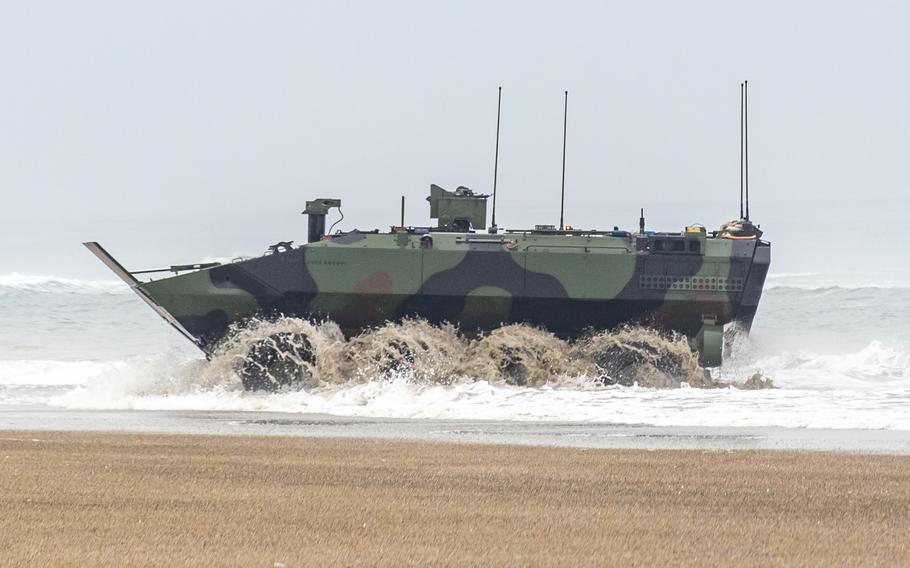
An amphibious combat vehicle fords back to shore for a final evaluation during a certification course at Marine Corps Base Camp Pendleton, Calif., in July 2023. (Mhecaela Watts/U.S. Marine Corps)
The Marine Corps is sending its new amphibious combat vehicle to the Pacific with an expeditionary unit from California, the Corps’ acting commandant said Thursday.
The new additions to the service’s inventory will arrive on Okinawa with the 15th Marine Expeditionary Unit from Camp Pendleton, Calif., Gen. Christopher Mahoney said during an event at the Hudson Institute in Washington, D.C.
The eight-wheeled amphibious combat vehicles, or ACVs, move troops from ship to shore and are designed to ride the surf close to shore during assaults. They are essential to the Marines’ force redesign that aims to structure the Corps as a distributed, light strike force equipped to fight across Pacific islands.
The combat vehicles deploying with the 15th MEU will “become part of the Okinawa contingent once they get out there,” Mahoney said without elaboration.
The ACV, first developed by BAE Systems of York, Pa., under a $67 million contract in June 2019, replaces the amphibious assault vehicles whose use by the Corps concluded not long after the accidental deaths of nine crew in July 2020.
Eight Marines and a Navy corpsman drowned when their amphibious assault vehicle sank off the coast of Southern California. An investigation blamed the sinking and fatalities on poor training, bad judgment and shabby maintenance, but the mishap also underscored the assault vehicle’s deficiencies.
In fall 2020, BAE Systems received a $184 million contract for “full-rate production’ of the amphibious combat vehicle, according to the company website, and late the following year the Corps announced it would replace the aging, tracked amphibious vehicles with the new, wheeled vehicles.
The replacement ACVs have had their own set of problems, both on land and sea.
The Corps halted ACV training in rough waters after one of them rolled over in the surf zone near Camp Pendleton in October 2022. There were no fatalities.
In December, a Marine with the 15th MEU died when the ACV he was in rolled over at Pendleton.
Mahoney told the audience that the service is working toward lifting training restrictions on the ACVs to get them back into “unprotected waters.”
“There are a couple of more things to go, but I’m confident that we will get the training, get the procedures and the methods, to the level that we need to be confident in rough-sea states,” he said.
Mahoney, the assistant commandant, is standing in for Commandant Gen. Eric Smith, who is recovering from an Oct. 29 heart attack, a month after being sworn in by Navy Secretary Carolos Del Toro.
Defense News reported Friday that the Boxer Amphibious Ready Group will deploy from the West Coast in phases this spring with the amphibious assault ship USS Boxer and dock landing ship USS Harpers Ferry, from which the ACVs would deploy, expected to depart in March.